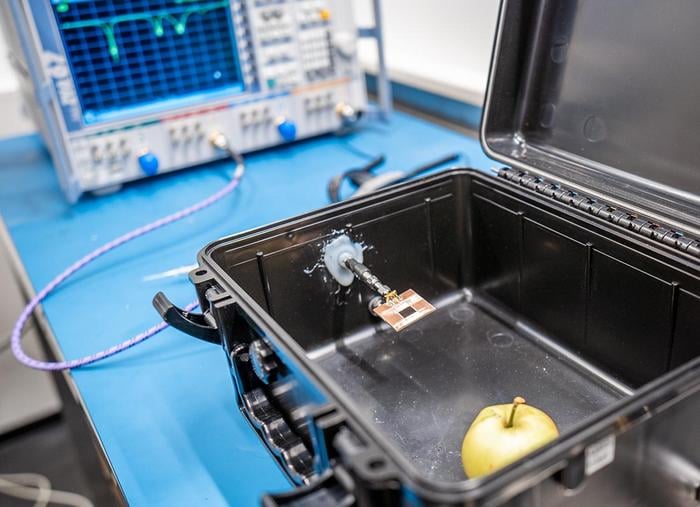Researchers have developed an antenna-based sensor that can detect volatile organic compounds with high accuracy, potentially revolutionizing food safety and disease detection.
Summary: Scientists at the Norwegian University of Science and Technology have created an artificial ‘nose’ using antenna technology that can identify spoiled meat, damaged fruit, and potentially even diseases, with 96.7% accuracy.
Estimated reading time: 6 minutes
In a world increasingly concerned with food safety and early disease detection, a new technological breakthrough promises to bring the power of scent detection to our fingertips. Researchers at the Norwegian University of Science and Technology (NTNU) have developed an artificial ‘nose’ that can detect volatile organic compounds (VOCs) with remarkable accuracy, potentially transforming how we identify spoiled food, damaged produce, and even undiagnosed diseases.
The Power of Antenna Technology
The key to this innovation lies in repurposing a technology that surrounds us daily: antennas. Professor Michael Cheffena of NTNU explains the rationale behind this approach:
“We are literally surrounded by technology that communicates using antenna technology. By giving the antennas sensor functions, the existing infrastructure can be used in new areas of application. This has been one of the main motivations for investigating whether antennas can be used for these purposes.”
Unlike previous attempts at creating electronic noses, which often required hundreds of sensors coated with different materials, this new approach utilizes a single antenna with one type of coating. This simplification brings several advantages:
- Lower power consumption
- Reduced manufacturing costs
- Decreased material usage
How It Works
The antenna ‘nose’ operates by transmitting radio signals at various frequencies and analyzing how they are reflected back. Different gases present in the environment affect these reflections, creating unique patterns that can be linked to specific VOCs.
Yu Dang, a PhD research fellow at NTNU and lead author of the study published in Sensors and Actuators B: Chemical, highlights the sensor’s impressive performance:
“Our sensor distinguishes between the different gases it has been tested on with an accuracy of 96.7 per cent. This is a result that is not only on par with the performance of the best electronic noses to date, but in some areas, it even surpasses them.”
One of the most significant achievements of this technology is its ability to differentiate between isomers – chemical compounds with the same molecular formula but slightly different atomic arrangements. This capability has long been a challenge for sensor technology, even in sophisticated multi-sensor systems.
Practical Applications
The potential applications for this technology are vast and exciting:
- Food Safety: The sensor has already been tested on impact-damaged fruits and meats of varying ages, demonstrating its ability to detect spoilage.
- Disease Detection: By adjusting the algorithms that detect the unique ‘fingerprints’ of different gases, the researchers believe the technology may be able to smell diseases, similar to how trained dogs can detect changes in blood sugar or cancer.
- Industrial Uses: The sensor could potentially be used to detect hazardous gases in industrial settings.
- Environmental Monitoring: The technology could be applied to monitor air quality and detect pollutants.
Advantages Over Existing Methods
Compared to other methods of VOC detection, including trained animals, this antenna-based sensor offers several advantages:
- No need for months of training or specialized handlers
- Utilizes existing technology infrastructure
- High accuracy, even with challenging compounds like isomers
- Potentially lower cost and easier implementation
Future Directions
While the results are promising, further research and development will be necessary to fully realize the potential of this technology. Some areas for future investigation include:
- Testing the sensor’s performance in a wider range of real-world scenarios
- Developing specific algorithms for disease detection
- Exploring potential integration with existing communication infrastructure
- Investigating the sensor’s long-term reliability and durability
As this technology continues to evolve, it could play a crucial role in enhancing food safety, improving disease detection, and creating more efficient industrial processes. The simplicity and effectiveness of this antenna-based ‘nose’ may soon bring the power of advanced scent detection to a wide range of applications, potentially improving health outcomes and reducing waste on a global scale.
Quiz: Test Your Knowledge
- What is the accuracy rate of the new antenna-based sensor in distinguishing between different gases? a) 86.7% b) 91.3% c) 96.7% d) 99.9%
- What type of compounds has this sensor shown a particular ability to differentiate between? a) Proteins b) Carbohydrates c) Isomers d) Lipids
- Which of the following is NOT mentioned as a potential application for this technology? a) Detecting spoiled food b) Identifying diseases c) Monitoring air quality d) Predicting weather patterns
Answer key:
- c
- c
- d
Glossary of Terms
- Volatile Organic Compounds (VOCs): Gases emitted by various substances that easily become vapors or gases at room temperature.
- Isomers: Chemical compounds with the same molecular formula but different structural arrangements of atoms.
- Antenna: A device used to transmit or receive electromagnetic waves.
- Electronic nose (E-nose): A device that mimics the human olfactory system to detect odors and flavors.
- Radio signals: Electromagnetic waves used for wireless communication.
Enjoy this story? Get our newsletter! https://scienceblog.substack.com/


